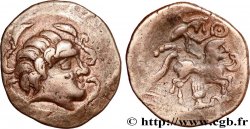v57_0412 - PICTONES (Area of Poitiers) Quinaire aux mèches aquitaniques
MONNAIES 57 (2013)
Starting price : 250.00 €
Estimate : 400.00 €
Realised price : 250.00 €
Number of bids : 1
Maximum bid : 781.00 €
Starting price : 250.00 €
Estimate : 400.00 €
Realised price : 250.00 €
Number of bids : 1
Maximum bid : 781.00 €
Type : Quinaire aux mèches aquitaniques
Date: c. 80-60 AC.
Mint name / Town : Poitiers (86)
Metal : silver
Diameter : 11 mm
Orientation dies : 7 h.
Weight : 0,81 g.
Rarity : R3
Coments on the condition:
Monnaie frappée sur un flan un peu court mais avec des types complets. Frappe vigoureuse et centrée avec un métal très légèrement concrétionné par endroits avec une patine grise
Catalogue references :
Obverse
Obverse legend : ANÉPIGRAPHE.
Obverse description : Tête à droite, les cheveux épars avec de grosses mèches.
Reverse
Reverse legend : ANÉPIGRAPHE.
Reverse description : Personnage debout derrière un cheval à droite.
Commentary
Ce quinaire peut s'intégrer dans la série 1088 "fractions en argent des peuples centraux". Contrairement aux autres monnaies de ce genre qui ont un cavalier, ce quinaire semble avoir un personnage debout et de face, derrière le cheval. Le traitement de la chevelure est typique des drachmes picto-santones aux mèches aquitaniques et ne correspond pas aux autres monnaies de la série 1088. Cet exemplaire est le second que nous proposons, après le n° 898 de MONNAIES 32, mais c’est aussi le plus beau et le plus complet !.








 Report a mistake
Report a mistake Print the page
Print the page Share my selection
Share my selection Ask a question
Ask a question Consign / sell
Consign / sell
 Full data
Full data









